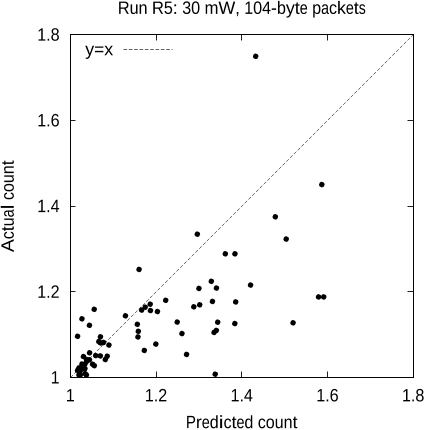




Did you find this useful? Give us your feedback




















28,685 citations
4,205 citations
2,633 citations
...Although the ETX metric performs better than shortestpath routing [ 15 , 16], it will not necessarily select good routes in the two scenarios discussed earlier....
[...]
...The values of pf and pr can be approximated by using the broadcast packet technique described by De Couto et al. [ 15 ]....
[...]
...Following the methodology of [ 15 ], we selected 100 of these pairs at random....
[...]
...In this section, we will focus on the ETX (Expected Transmission Count) routing metric proposed by De Couto et al. [ 15 ]....
[...]
...This assumption is usually true for short paths, but the assumption is somewhat pessimistic for longer paths [ 15 ]....
[...]
2,190 citations
...The proposed solutions range from designing better routing metrics [ 31 ]–[33] to tweaking the TCP protocol [34], and include improved routing and MAC protocols [35], [36]....
[...]
...For e.g., the ETX metric [ 31 ] periodically computes the delivery probabilities and assigns each link a weight equal to 1/(delivery probability)....
[...]
1,575 citations
...The graph indicates the distance that each transmission traveled, as measured in di.erence in ETX metric to N24 between the transmitter and receiver....
[...]
...The traditional route is chosen using the ETX metric, which has been shown to .nd the best routes [4, 5] when the link loss measurements are accurate....
[...]
...Each node s ETX value is the sum of the link ETX values along the lowest-ETX path to ETX = 2.28 ETX = 1.17 Figure 5: Estimated transmission count (ETX) to node E from each node in the sample network from Figure 4....
[...]
...Multi-hop wireless networks typically use routing techniques similar to those in wired networks [15, 16, 9, 4, 5]....
[...]
...7000 Packet Transmissions 1500 1000 500 0 Figure 12: Distance traveled towards N24 in ETX space by each transmission....
[...]
28,685 citations
...11b MAC can be unfair under high load [3]....
[...]
12,497 citations
11,412 citations
...With variable power radios, it might be preferable to maximize hop-count, thereby decreasing interference and minimizing the energy used by each packet [29, 12, 18]....
[...]
...Existing systems exploit this idea, often with a focus on minimizing the energy consumption required to successfully deliver data [12, 18, 29]....
[...]
11,360 citations
...Much of the recent work in ad hoc routing protocols for wireless networks [25, 15, 26] has focused on coping with mobile nodes, rapidly changing topologies, and scalability....
[...]
6,877 citations
Several aspects of ETX could be improved in the future: its predictions of loss ratios for different packet sizes, particularly for 802.
Minimizing the hop-count maximizes the distance traveled by each hop, which is likely to minimize signal strength and maximize the loss ratio.
The nodes do not perform packet salvage, in which forwarding nodes, in the event of a transmission failure or received route error, attempt to find alternate routes for queued packets.
If a transmission failure occurs when forwarding a route reply, the neighbor to which the node was trying to forward the reply is added to the blacklist, with an entry of unidirectionality probable.
The delay-use modification causes DSDV to delay using a newly received route until it is permitted to advertise the route (i.e. 2×WST has passed).
the small packets are still useful for detecting very asymmetric links, which is why ETX’s gain over minimum is more pronounced to the left of the graph, where hop-count used very asymmetric links.
In DSR experiments with ETX, the source waits an additional 15 seconds before initiating the route request, to give the nodes time to accumulate link measurements.
ACK packets are only 38 bytes in total, including all 802.11b overhead, while the 134-byte data packets used in most of the experiments are 193 bytes with 802.11b overhead.
Each data packet in the following measurements consists of 24 bytes of 802.11b preamble, 31 bytes of 802.11b and Ethernet encapsulation header, 134 bytes of data payload, and 4 bytes of frame check sequence: 193 bytes in total.
If a node is sending large volumes of data, there is a danger that probe packets or routing protocol packets may be dropped or delayed due to a full queue.
Because each attempt to transmit a packet can be considered a Bernoulli trial, the expected number of transmissions is:ETX = 1df × dr (1)ETX has several important characteristics:• ETX is based on delivery ratios, which directly affect throughput.•
The points for two pairs in Figure 7 lie well below the y = x line; this is because of variations in link quality between the ETX and minimum hop-count tests for those pairs.
A single-hop direct route can deliver up to about 450 packets per second, but the fastest two-hop route has only half that capacity.
The minimum hop-count routes are slow because they include links with high loss ratios, which cause bandwidth to be consumed by retransmissions.
Minimum hop-count is using links that deliver routing updates in one direction but deliver few or no data packets in the other, while ETX correctly avoids those links.